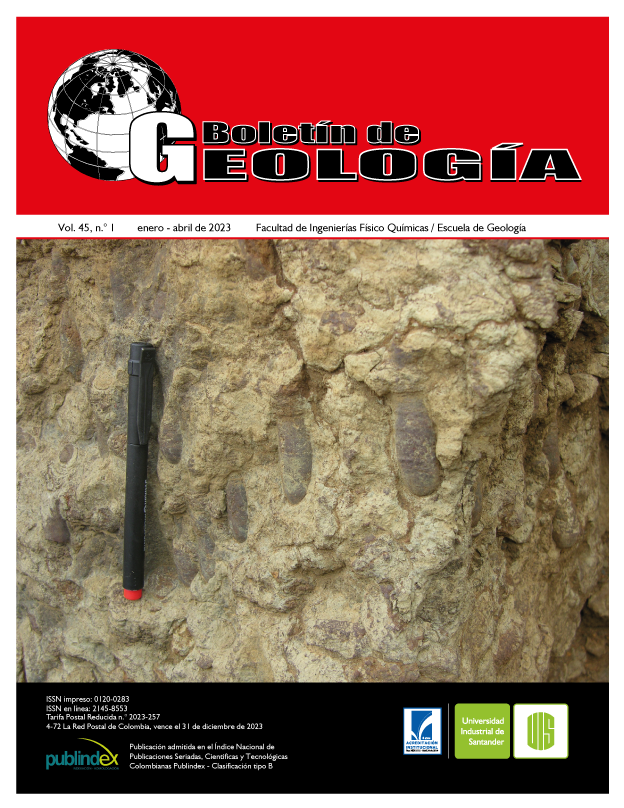Modelo neuronal para estimar valores de permeabilidad a partir de registros de pozo y análisis de núcleos
Publicado 2023-02-28
Palabras clave
- Determinación de permeabilidad,
- Redes neuronales,
- Muestras de núcleo,
- Propiedades de la roca,
- Caracterización de yacimientos
- Heterogeneidad en rocas ...Más
Cómo citar
Derechos de autor 2023 Boletín de Geología

Esta obra está bajo una licencia internacional Creative Commons Atribución 4.0.
Altmetrics
Resumen
Se presenta un caso de estudio donde se pone a prueba la efectividad de las redes neuronales para determinar la permeabilidad en medios rocosos heterogéneos a partir de propiedades básicas de las rocas. El conjunto de datos usado se conforma de 213 muestras de núcleo de las formaciones Morrow y Viola encontradas en el estado de Kansas, Estados Unidos. Los parámetros caracterizadores de las muestras de núcleos son porosidad (ϕ), saturación de agua y aceite (Sw y So) y densidad de grano (GD), y las variables adicionales de registros de pozo son registro resistivo (ILD), rayos gamma (GR) y neutrón-porosidad (NPHI). Las predicciones neuronales son comparadas con resultados obtenidos por tres modelos semiempíricos (Timur, Coates y Pape) ampliamente usados en la caracterización de yacimientos. Se concluye que la red neuronal provee la mejor predicción por sobre todos los modelos presentados cuantificándose mediante el coeficiente de correlación (R y R2) más alto, muy por encima de aquellos valores obtenidos mediante los métodos convencionales en formaciones con heterogeneidad en rocas y compleja naturaleza diagenética. Aplicando el método de Timur el R resultó de 0,58 y el R2 de 0,343, con el modelo de Coates se obtuvo un R de 0,60 y un R2 de 0,365; con el modelo de Pape el R fue de 0,60 y el R2 fue de 0,372, mientras que con el modelo neuronal se obtuvieron 0,97 y 0,94 para R y R2, respectivamente.
Descargas
Referencias
- Adams, W. (1964). Diagenetic aspects of lower Morrowan, Pennsylvanian Sandstones, northwestern Oklahoma. AAPG Bulletin, 48(9), 1368-1580. https://doi.org/10.1306/BC743DA1-16BE-11D7-8645000102C1865D
- Aggarwal, C. (2018). Neural networks and deep learning. Springer.
- Al Khalifah, H.; Glover, P.; Lorinczi, P. (2020) Permeability prediction and diagenesis in tight carbonates using machine learning techniques. Marine and Petroleum Geology, 112, 104096. https://doi.org/10.1016/j.marpetgeo.2019.104096
- Bhattacharya, S. (2021). A primer on machine learning in subsurface geosciences. Springer.
- Bornemann, O. (1982). Stratigraphie und tektonik des zechsteins im salzstock gorleben auf grund von Bohrergebnissen. Zeitschrift der Deutschen Geologischen Gesellschaft, 133(2), 119-134. https://doi.org/10.1127/zdgg/133/1982/119
- Caldwell, C.; Boeken, R. (1985). Wireline log zones and core description of upper part of the Middle Ordovician Viola Limestone, McClain and McClain SW fields, Nemaha County, Kansas. Subsurface Geology Series, 6, 17-35.
- Coates, G.; Dumanoir, J. (1973). A new approach to improved Log-Derived permeability. SPWLA 14th Annual Logging Symposium, Lafayette, USA.
- Coates, GR.; Miller, M.; Henderson, G. (1991). The MRIL in Conoco 33-1: an investigation of a new magnetic resonance imaging log. SPWLA 32nd Annual Logging Symposium, Midland, Texas. SPWLA-1991-DD.
- Coolen, C. (1998). A Begginer’s guide to the mathematics of neural networks. King’s College.
- Cranganu, C. (2015). Artificial intelligence approaches in petroleum geosciences. Springer.
- DeVries, A. (2006). Sequence stratigraphy and facies analysis of the Upper Morrow sandstone, Mustang East Field, Morton County, Kansas. AAPG Mid- Continent Section Meeting, Oklahoma City, USA.
- Eriavbe, F.; Okene, U. (2019). Machine learning applications to permeability prediction using log & core measurements: a realistic workflow application for reservoir characterization. SPE Nigeria Annual International Conference and Exhibition, Lagos, Nigeria. https://doi.org/10.2118/198874-MS
- García-Benítez, S.R.; López-Molina, J.A.; Castellanos-Pedroza, V. (2016). Neural networks for defining spatial variation of rock properties in sparsely instrumented media. Boletín de la Sociedad Geológica Mexicana, 68(3), 553-570. https://doi.org/10.18268/BSGM2016v68n3a10
- Goodfellow, I.; Bengio, Y.; Courville, A. (2016). Deep learning. MIT press.
- Habibian, B.; Nabi-Bidhendi, M. (2005). Permeability prediction from wireline logs using artificial neural networks. Journal of the Earth and Space Physics, 31(1), 79-86.
- Helle, H.B.; Bhatt, A.; Ursin, B. (2001). Porosity and permeability prediction from wireline logs using neural networks: a North Sea case study. Geophysical Prospecting, 49(4), 431-444. https://doi.org/10.1046/j.1365-2478.2001.00271.x
- KGS (2020). Kansas Geological Survey - The University of Kansas. http://www.kgs.ku.edu/PRS/petroIndex.html
- Kohli, A.; Arora, P. (2014). Application of artificial neural networks for well logs. International Petroleum Technology Conference, Doha, Qatar. https://doi.org/10.2523/IPTC-17475-MS
- Maslennikova, Y. (2013). Permeability prediction using hybrid neural network modeling. SPE Annual Technical Conference and Exhibition, New Orleans, USA. https://doi.org/10.2118/167640-STU
- Matich, D. (2001). Redes neuronales: conceptos básicos y aplicaciones. Universidad Tecnológica Nacional.
- Mohaghegh, S.; Balan, B.; Ameri, S. (1997). Permeability determination from well log data. SPE Formation Evaluation, 12(3), 170-174. https://doi.org/10.2118/30978-PA
- Pape, H.; Clauser, C.; Iffland, J. (1999). Permeability prediction based on fractal pore-space geometry. Geophysics, 64(5), 1447-1460. https://doi.org/10.1190/1.1444649
- Puckette, J.; Abdalla, A.; Rice, A.; Al-Shaieb, Z. (1996). The Upper Morrow Reservoirs: Complex Fluvio-deltaic Depositional Systems. Oklahoma Geological Survey, 98, 47-84.
- Rascoe, B.; Adler, F. (1983). Permo-carboniferous hydrocarbon accumulations, Mid-continent, USA. AAPG Bulletin, 67(6), 979-1001. https://doi.org/10.1306/03B5B6E1-16D1-11D7-8645000102C1865D
- Rumelhart, D.E.; Hinton, G.E.; Williams, R.J. (1986). Learning representations by back-propagating errors. Nature, 323, 533-536. https://doi.org/10.1038/323533a0
- Saner, S.; Kissami, M.; Al-Naufaili, S. (1997). Estimation of permeability from well logs using resistivity and saturation data. SPE Formation Evaluation, 12(1), 27-31. https://doi.org/10.2118/26277-PA
- Shang, B.Z.; Hamman, J.; Chen, H.; Caldwell, D. (2003). A model to correlate permeability with efficient porosity and irreducible water saturation. SPE Annual Technical Conference and Exhibition, Denver, USA. https://doi.org/10.2118/84303-MS
- Singh, S. (2005). Permeability prediction using artificial neural network (ANN): a case study of Uinta Basin. SPE Annual Technical Conference and Exhibition, Dallas, Texas. https://doi.org/10.2118/99286-STU
- Timur, A. (1968). An investigation of permeability, porosity, and residual water saturation relationship for sandstone reservoirs. The Log Analyst, 9(4). SPWLA-1968-J.

